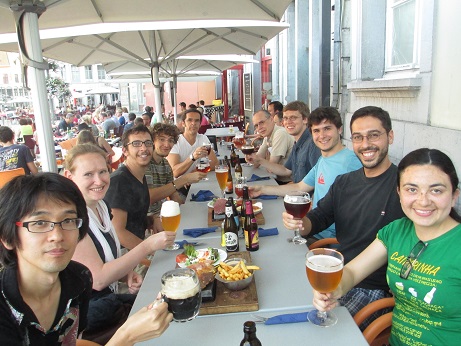Isabella and João are now Masters
Tuesday, September 10, 2013Isabella Carucci and João Rico have (very) successfully defended their MSc thesis, both with the highest possible scores. Isabella thesis was on Matter around black holes and Mergers of dark matter halos, and João’s was on Testing the Kerr hypothesis. They are both available here .
Congratulations to both Masters!
Review on construction of black hole solutions
Friday, August 2, 2013Exact solutions of the non-linear equations of General Relativity without spherical symmetry are notoriously difficult to discover. For example, it took roughly 50 years to generalize the static four dimensional Schwarzschild black hole to the rotating case - the Kerr solution.
In the past couple of years, tremendous progress in the generation of charged black hole solutions in higher dimensions has been possible by combining solution-generating and dimensional reduction techniques, both of which have been known for many decades. These methods culminated with the construction of the most general black ring solution of a certain gravitational theory.
The invited review Charged black rings from inverse scattering by Jorge Rocha and collaborators, soon to be published in the journal General Relativity and Gravitation, sums up recent advances obtained in the generation of charged black ring solutions in higher dimensions and pedagogically describes the methods employed.
Black holes: a tale of cannibalism
Wednesday, July 31, 2013Black holes: a tale of cannibalism
Our group just uncovered a curious case of cannibalism among black holes. It’s well known that black hole encounters give birth to gravitational waves. For encounters at close to the speed of light, surprising results emerge: the black holes, regardless of their structure, eat half of their gravitational-wave progeny. These results may change the way we think about ultra-relativistic collisions and black hole production and are the outcome of a recent study published in Physical Review Letters
The universe is populated by millions of black holes — such as the one at the center of our own galaxy — and collisions between black holes are thought to be a relatively common event. When they collide, colossal amounts of gravitational waves are created. These waves are travelling ripples in spacetime fabric, the same fabric black holes are made of. According to the team’s results, when black holes collide at very large speeds they swallow the waves they generated…thus, two small black holes colliding at large energies may result in two slowly moving, fat black holes.
This study, by Sperhake, Berti, Cardoso and Pretorius, provides more insight on the way black holes are born, how they interact and how they emit gravitational waves. These waves have also been called Einstein messengers, and are currently being studied and scrutinized by hundreds of scientists worldwide.
Permanent position for Sayan
Tuesday, July 30, 2013Sayan Chakrabarti is leaving us, but for a good reason: he got a permanent position at the Indian Institute Of Technology Guwahati. Congratulations Sayan!
GR20 in Warsaw and MM13 in Mons
Sunday, July 28, 2013
The group recently went to Warsaw for the GR20 meeting, and to Mons for the MM13 meeting. The picture above was taken in Mons, in the main, “Monkey” square.